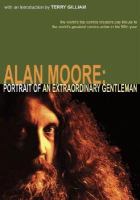Alan Moore: Comics as Performance, Fiction as Scalpel

(This book can be considered a spoiler and should not be read prior to any of Alan Moore's fiction if the reader is concerned about stumbling across plot points.)
This title is part of an ongoing Great Comics Artists series and provides an overview of Alan Moore's life and work as an influential force in comics and popular culture. Chapters deal with specific works as well as issues addressed across Moore's bibliography, such as LGBT civil rights in England in the 1980s and English geographical identity in literature, and Moore's performance art is also discussed. It is an excellent source for those looking for historical context and social commentary in Moore's pieces. It includes an index and chronological bibliography.
Di Liddo, A., (2009). Alan Moore : Comics as performance, fiction as scalpel. Jackson: University Press of Mississippi.
Top of Page
This title is part of an ongoing Great Comics Artists series and provides an overview of Alan Moore's life and work as an influential force in comics and popular culture. Chapters deal with specific works as well as issues addressed across Moore's bibliography, such as LGBT civil rights in England in the 1980s and English geographical identity in literature, and Moore's performance art is also discussed. It is an excellent source for those looking for historical context and social commentary in Moore's pieces. It includes an index and chronological bibliography.
Di Liddo, A., (2009). Alan Moore : Comics as performance, fiction as scalpel. Jackson: University Press of Mississippi.
Top of Page
Alan Moore: Portrait of an Extraordinary Gentleman

This book is a conglomeration of artists' and writers' tributes to Alan Moore in honor of his 50th birthday. It includes personal recollections, tribute art, critical essays, and an excellent biographical comic at the beginning of the book. This is a wonderful biographical resource, as the recollections span almost the entirety of Moore's career, and many artists and writers describe his influence on their formative work.
Gilliam, T., & Millidge, G. Spencer. (2003). Alan Moore : Portrait of an extraordinary gentleman. Leigh-on-sea, England: Abiogendsis Press
Top of Page
Gilliam, T., & Millidge, G. Spencer. (2003). Alan Moore : Portrait of an extraordinary gentleman. Leigh-on-sea, England: Abiogendsis Press
Top of Page
"See the Strings: Watchmen and the Under-Language of Media"

This chapter focuses on the overwhelming amount of visual symbolism and duality in what is perhaps Alan Moore's most well known graphic novel, The Watchmen, highlighting the usage of clocks and the usage of clocks and time pieces, the familiar iconic smiley face, and doubleness. The chapter is framed in the context of a work attempting to describe current popular culture and the convergence of various postmodern forms of media therein. It is particularly useful for its description of the visual aesthetic in Watchmen--an aspect not often touched on in other resources.
Moulthrop, Stuart. (2009). See the Strings: Watchmen and the Under-Language of Media. In Pat Harrigan's and Noah Wardrip-Fruin's Third Person. Cambridge, MA: MIT Press
Top of Page
Moulthrop, Stuart. (2009). See the Strings: Watchmen and the Under-Language of Media. In Pat Harrigan's and Noah Wardrip-Fruin's Third Person. Cambridge, MA: MIT Press
Top of Page
Watchmen and Philosophy: A Rorschach Test

Alan Moore's Watchmen is set in 1985 and chronicles the alternative history of the United States where the US edges dangerously closer to nuclear war with the Soviet Union. Within this world exists a group of crime busters, who don elaborate costumes to conceal their identity and fight crime, and an intricate plot to kill and discredit these "superheroes." Alan Moore's Watchmen popularized the graphic novel format, has been named one of Time magazine's top 100 novels, and is now being made into a highly anticipated movie adaptation. This latest book in the popular Blackwell Philosophy and Pop Culture series peers into Moore's deeply philosophical work to parse and deconstruct the ethical issues raised by Watchmen's costumed adventurers, their actions, and their world. From nuclear destruction to utopia, from governmental authority to human morality and social responsibility, it answers questions fans have had for years about Watchmen's ethical quandaries, themes, and characters.
White, M D. (2009). Watchmen and philosophy : A Rorschach test. Hoboken, N.J.: John Wiley & Sons.
(Description courtesy of www.lib.unc.edu)
Top of Page
White, M D. (2009). Watchmen and philosophy : A Rorschach test. Hoboken, N.J.: John Wiley & Sons.
(Description courtesy of www.lib.unc.edu)
Top of Page
